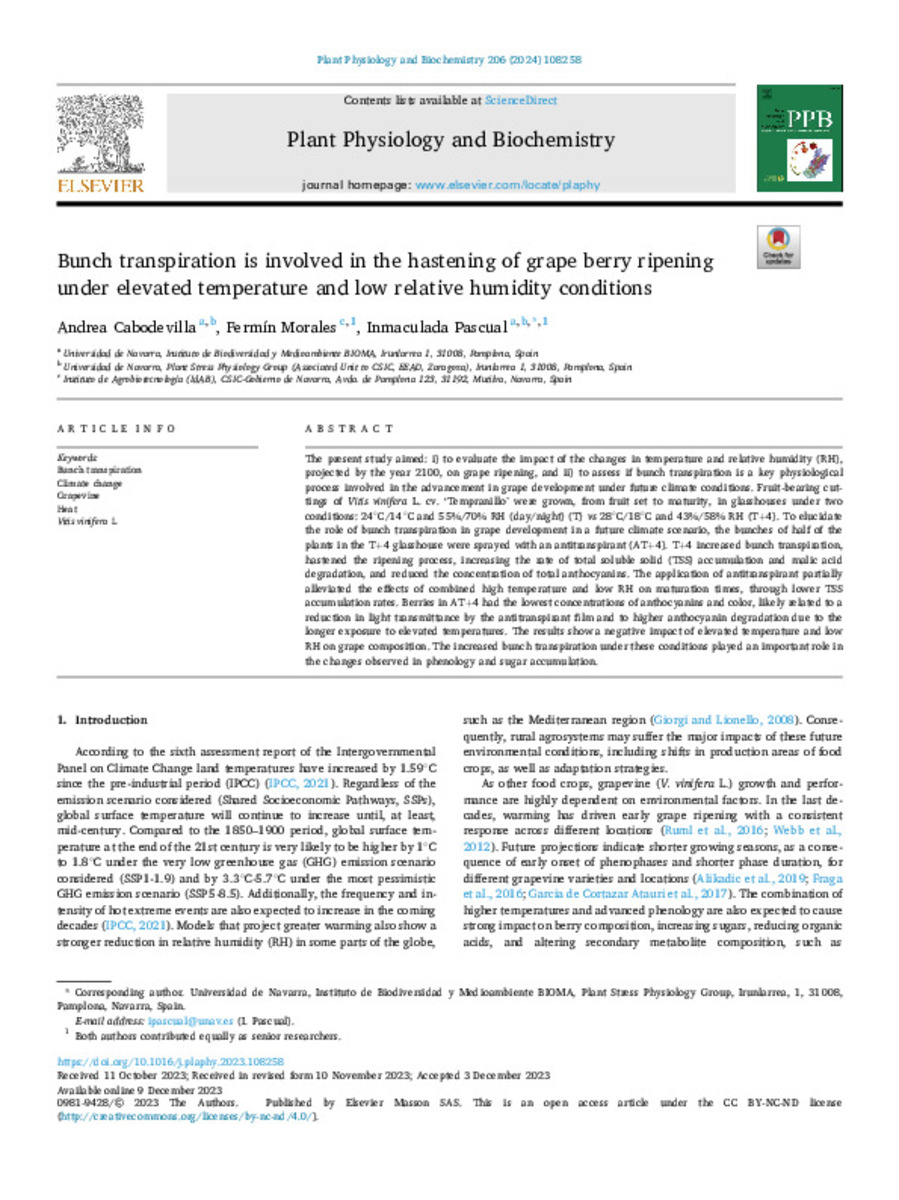Full metadata record
| DC Field | Value | Language |
|---|---|---|
| dc.creator | Cabodevilla, A. (Andrea) | - |
| dc.creator | Morales, F. (Fermin) | - |
| dc.creator | Pascual, I. (Inmaculada) | - |
| dc.date.accessioned | 2024-03-26T09:30:10Z | - |
| dc.date.available | 2024-03-26T09:30:10Z | - |
| dc.date.issued | 2024 | - |
| dc.identifier.citation | Cabodevilla, A. (Andrea); Morales, F. (Fermin); Pascual, I. (Inmaculada). "Bunch transpiration is involved in the hastening of grape berry ripening under elevated temperature and low relative humidity conditions". Plant Physiology and Biochemistry. 206 (108258), 2024, 108258 | es_ES |
| dc.identifier.issn | 0981-9428 | - |
| dc.identifier.uri | https://hdl.handle.net/10171/69282 | - |
| dc.description.abstract | The present study aimed: i) to evaluate the impact of the changes in temperature and relative humidity (RH), projected by the year 2100, on grape ripening, and ii) to assess if bunch transpiration is a key physiological process involved in the advancement in grape development under future climate conditions. Fruit-bearing cuttings of Vitis vinifera L. cv. ‘Tempranillo’ were grown, from fruit set to maturity, in glasshouses under two conditions: 24°C/14°C and 55%/70% RH (day/night) (T) vs 28°C/18°C and 43%/58% RH (T+4). To elucidate the role of bunch transpiration in grape development in a future climate scenario, the bunches of half of the plants in the T+4 glasshouse were sprayed with an antitranspirant (AT+4). T+4 increased bunch transpiration, hastened the ripening process, increasing the rate of total soluble solid (TSS) accumulation and malic acid degradation, and reduced the concentration of total anthocyanins. The application of antitranspirant partially alleviated the effects of combined high temperature and low RH on maturation times, through lower TSS accumulation rates. Berries in AT+4 had the lowest concentrations of anthocyanins and color, likely related to a reduction in light transmittance by the antitranspirant film and to higher anthocyanin degradation due to the longer exposure to elevated temperatures. The results show a negative impact of elevated temperature and low RH on grape composition. The increased bunch transpiration under these conditions played an important role in the changes observed in phenology and sugar accumulation. | es_ES |
| dc.description.sponsorship | This work was supported by Gobierno de Navarra (grant numbers: PT035-036 SENSOR, PT005-006 SENSOR 2 and PC144-145 MULTISENSOR); and Asociación de Amigos de la Universidad de Navarra (predoctoral contract for A. Cabodevilla). | es_ES |
| dc.language.iso | eng | es_ES |
| dc.publisher | Elsevier | es_ES |
| dc.rights | info:eu-repo/semantics/openAccess | es_ES |
| dc.subject | Bunch transpiration | es_ES |
| dc.subject | Climate change | es_ES |
| dc.subject | Grapevine | es_ES |
| dc.subject | Heat | es_ES |
| dc.subject | Vitis vinifera L | es_ES |
| dc.title | Bunch transpiration is involved in the hastening of grape berry ripening under elevated temperature and low relative humidity conditions | es_ES |
| dc.type | info:eu-repo/semantics/article | es_ES |
| dc.description.note | This is an open access article under the CC BY-NC-ND license | es_ES |
| dc.identifier.doi | 10.1016/j.plaphy.2023.108258 | - |
| dadun.citation.number | 108258 | es_ES |
| dadun.citation.publicationName | Plant Physiology and Biochemistry | es_ES |
| dadun.citation.volume | 206 | es_ES |
| dc.identifier.pmid | 38096731 | - |
Files in This Item:
Statistics and impact
Items in Dadun are protected by copyright, with all rights reserved, unless otherwise indicated.






